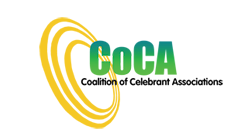SMEG: Suggested Approach to Assessment and Evidence Requirements for Selected Celebrancy Units of Competency –
CHCCEL002 Establish client celebrancy needs
Suggested assessment activities:
Researched and provided detailed feedback on the following:
- the definition of ceremony and its purpose
- the role of ceremony in human history and society
- the common structures of ceremony
- the importance of dignity, inspiration, truth, humour, beauty, compassion, respect and other values for building stronger couple, family and community relationships via ceremony
- the theatre of ceremony, including the role of a celebrant, presider or leader in ceremony, participants and audience
- different ceremonial elements with respect to how these impact on different individuals and groups
- the development of in Australia of marriage, funeral, other family based ceremonies and celebrations, and community based ceremonies such as the Opening of the Olympics and ANZAC Day ceremonies, with manifold other examples of rituals and celebration that are vital to the fabric of Australian society
Interviewed of members from each of the following local communities
- Aboriginal Australian community
- the celebrant’s own cultural or language background
- a different cultural or language background to the celebrant’s
- the role of ceremony in their cultural life,
- its structure and
- the ways in which their community members participate in the ceremony
Researched and created a list the range of written material for which a celebrant would need effective writing skills, including
- defining the purpose of the material
- defining the target group/s of the material
- documenting the action/outcome needed of the different target audiences required by the different types of written materials, and
- summarising the key writing principles underpinning the different types of written materials listed for their effective use in celebrancy
- About Me
- Services Offered
- Why engage an independent (civil/ religious) celebrant
- Why choose me as your celebrant
- English as first language speakers
- speakers from non-English backgrounds
and explained the rationale for the differences in terms of their written content
Prepared, assessed, revised and documented the following:
• An introduction letter to potential clients for each of the following:
- Wedding Anniversaries,
- Valentine’s Day ceremonies
- Commitment ceremonies
- Baby Namings
- Coming of Adolescence or Coming of Age ceremonies (18 + 21 years)
- Loss and grief related celebrant services
• Letters of introduction to other celebration vendors and / or funeral vendors for
- Marriage services
- Celebrant for all occasions
- Funeral and/ or Memorial services
• Text content of a hypothetical “Newspaper Article for the Role of The Family Celebrant” for readership in some or all of the following
- In a city area
- In a country area
for a population of multicultural backgrounds
- Targeted age group 30 years to 45 years
- Targeted age group 55 years to 70 years
Conducted six (6) prospective client phone interviews, at least one of each chosen from the following categories:
a) a “love ceremony” e.g. wedding, civil union and wedding anniversary
b) a “life ceremony” e.g. a pre-birth baby blessing, coming of age and senior birthday
c) a “loss” ceremony e.g. memorial, graduation or community ceremony
In these interviews, the celebrant displayed an ability to:
- identify needs of the client/s and manage differences in needs
- explain the purpose of the ceremony/ celebrancy service, role of the celebrant, client, participants, audience and associated personnel
- provide advice and information to clients about the place of art and culture
- assess client needs and match celebrancy services to address those needs in conjunction with the client
- explain the needs of the celebrant and the role of the client/s in relation to those
- outline one’s terms and conditions and proposed fees for service
- negotiate decision to agree to proceed or not with the service to be provided with the client/s, including whether the decision to proceed occurred or not was mutual
Conducted three (3) prospective face-to-face client interviews, at least one of each chosen from the following categories:
a) a “love ceremony” e.g. wedding, civil union and wedding anniversary
b) a “life ceremony” e.g. a pre-birth baby blessing, coming of age and senior birthday
c) a “loss” ceremony e.g. memorial, graduation or community ceremony
In these interviews, the celebrant displayed an ability to:
- identify needs of the client/s and manage differences in needs
- explain the purpose of the ceremony/ celebrancy service, role of the celebrant, client, participants, audience and associated personnel
- assess client needs and match celebrancy services to address those needs in conjunction with the clien
- explain the needs of the celebrant and the role of the client/s in relation to those
- outline one’s terms and conditions and proposed fees for service
- negotiate decision to agree to proceed or not with the service to be provided with the client/s, including whether the decision to proceed occurred or not was mutual
Prepared a checklist of factors that need to be considered in designing, organising and performing the ceremony
Created a sample format for the ceremony for inclusion in a Ceremony Planner
Negotiated and confirmed a celebrancy service agreement with at least (six) 6 clients at least one of each chosen from the following categories:
(a) a “love ceremony” e.g. wedding, civil union and wedding anniversary
(b) a “life ceremony” e.g. a pre-birth baby blessing, coming of age and senior birthday
(c) a “loss” ceremony e.g. memorial, graduation or community ceremony
including having conducted two face to face interviews with clients from at least two (2) different cultural or language backgrounds
and demonstrated
- respect and building a rapport with client/s
- an attitude of professionalism and compassion
- providing advice and information to clients about the place of art and culture in ceremony and
- assessing the client/s needs and desires for their ceremony
- understanding of their specific family and friendship relationships and the ways in which their ceremony may build stronger and more harmonious relationships
supported the client/s contribution to and participation in the ceremony/ritual(s) including identifying ways to express their values, culture, ideals and traditions in a variety of ways


